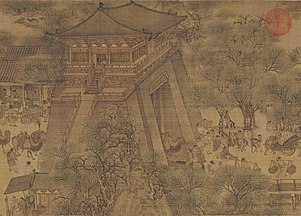
Back Al llarg del riu durant el Festival Qingming Catalan Qingming-Rolle German Laŭ La Rivero Dum Serena Festo Esperanto El festival Qingming junto al río Spanish Qingmingi festivali aegne jõeäär Estonian La Fête de Qingming au bord de la rivière French לאורך הנהר בשעת פסטיבל צ'ינגמינג HE Duž rijeke tijekom Qingming festivala Croatian Di Sepanjang Sungai Selama Festival Qingming ID 清明上河図 Japanese
| Along the River During the Qingming Festival | |
|---|---|
| 清明上河圖 | |
 A small section of the painting depicting scenes at the Bianjing city gate | |
| Artist | Zhang Zeduan |
| Year | 1085–1145 |
| Type | Ink and color on silk; handscroll |
| Dimensions | 25.5 cm × 525 cm (10.0 in × 207 in) |
| Location | Palace Museum, Beijing |
| Along the River During the Qingming Festival | |||||||||
|---|---|---|---|---|---|---|---|---|---|
| Traditional Chinese | 清明上河圖 | ||||||||
| Simplified Chinese | 清明上河图 | ||||||||
| |||||||||
Along the River During the Qingming Festival (simplified Chinese: 清明上河图; traditional Chinese: 清明上河圖; pinyin: Qingming Shanghe Tu) is a handscroll painting attributed to the Song dynasty painter Zhang Zeduan (1085–1145) and copied or recreated many times in the following centuries. It captures the daily life of people and the landscape of the capital, Bianjing (present-day Kaifeng) during the Northern Song. The theme is often said to be the spirit and worldly commotion at the Qingming Festival, rather than the holiday's ceremonial aspects, such as tomb sweeping and prayers. Read right to left, as a viewer would unroll it, successive scenes reveal the lifestyle of all levels of the society from rich to poor as well as economic activities in both rural areas and the city, and offer glimpses of clothing and architecture.[1] The painting is considered the most renowned work among all Chinese paintings,[2][3] and it has been called "China's Mona Lisa."[4][5]
As an artistic creation, the painting has been revered and artists of subsequent dynasties made hundreds of replicas, copies of copies, and even forgeries of well-regarded copies, each following the overall composition and the theme of the original but differing in detail and technique.[6] Over the centuries, the Song original was kept in private collections before it eventually returned to public ownership. The painting was a particular favorite of Puyi, the last emperor of China, who took it with him when he was forced to leave the Forbidden City in 1924. It was recovered in 1945 and kept at the Palace Museum in the Forbidden City. The Song original and later versions are regarded as national treasures and are exhibited only for brief periods every few years due to their delicate nature.[7]
- ^ Cite error: The named reference
Columbiawas invoked but never defined (see the help page). - ^ Kemp, Martin (2011). Christ to Coke: How Image Becomes Icon. Oxford University Press. p. 8. ISBN 978-0-19-161988-5.
...an image-making society second to none before the nineteenth century, the most famous painting is Qingming shanghe tu (Along the River During the Qing Ming Festival or Spring Festival on the River) by Zhang Zeduan, an artist working in the eleventh to twelfth century.
- ^ Cite error: The named reference
tnmwas invoked but never defined (see the help page). - ^ Bradsher, Keith (July 3, 2007). "'China's Mona Lisa' Makes a Rare Appearance in Hong Kong". The New York Times. Retrieved July 4, 2007.
- ^ Seno, Alexandra A. (July 15, 2007). "A Rare Look at 'China's Mona Lisa'". Newsweek. Retrieved June 4, 2024.
- ^ Bruce Doar, "International Conference on Qingming Shanghe Tu and Song Dynasty Genre Paintings, Beijing, 10–12 October 2005.," China Heritage Newsletter, China Heritage Project 4 (December 2005) [1]
- ^ Melvin, Sheila (January 11, 2003). "A Rare Peek at China's Treasures". The New York Times.
© MMXXIII Rich X Search. We shall prevail. All rights reserved. Rich X Search